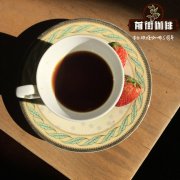Panamanian Angel Kiss BESO DE ANGEL introduces Panamanian coffee flavor

Professional coffee knowledge exchange more coffee bean information please follow the coffee workshop (Wechat official account cafe_style)
Official coffee production in Panama, which began in the early 20th century, is grown in the westernmost valleys and mountains of the country, dominated by mild-tasting Arabica beans, producing 82% of Arabica and 18% of Robusta varieties, respectively. The Chiriqui Plateau, grown at 2300-3500 feet (700-1070 m) above sea level, is considered to be the highest quality Arabica coffee in Panama, with the most famous boutique coffee in Boquete and Volcan producing areas because of its high rating in the international market and record prices.
It is said that the coffee grown in this area has a rich and charming taste, rich fruit tone and mild acidity. The reason is that almost all the coffee trees in the area grow under shade trees and use the best sunbathing on the scaffolding as a traditional way of handling raw beans. In addition, the farms in this area are processed by hand, and machines are used only in the wet grinding process. Therefore, in seed preservation, farming techniques and peeling methods, the tradition of generation after generation is preserved, and modern advanced technology is combined.
According to FAO statistics in 2013, the production of Panamanian coffee was 10100 tons, accounting for about 0.1 per cent of global production, with a planting area of 22400 hectares. From 1966 to 2005, coffee production statistics showed that production increased from less than 402 tons in 1961 to 1422 tons in 1985, but fell to 510 tons in 2014.
Coffee trees and crops in Panama are eventually affected by natural pests in other coffee-producing countries. The pests that have seriously affected the cultivation of coffee farms on 20097 hectares in recent years are iron rust, Ojo de Gallo and beetles.
Although Panama is a small coffee producer, its coffee is characterized by its ideal production environment, such as high altitude, volcanic soil, balance of water and sunlight caused by tropical plateau climate, many microclimates, many unique coffee flavor and taste, because coffee trees grow in high altitude areas (starting from 1.400 mts), low temperature and slow growth rate. Brewing a complete taste and aroma development.
Angel Kiss BESO DE ANGEL is planted in Chiriqui, Panama. The height of Haiba is 1500-1800 meters. Pure Panamanian Geisha, peeled berries in an African bed are naturally dried in sunny and Atlantic and Pacific whirling breezes. Angel kiss BESO DE ANGEL tastes like kissing a gentle breeze, full of unrestrained aroma, typical Panamanian Geisha full of warm orange aroma, because honey treatment makes the flavor super sweet and ripe into the sweetness of peach, the whole is like a delicate fruit flower tea tail rhyme is a long-lasting perfume and tea flavor
Qianjie recommended cooking parameters:
Hand punch: V60 filter cup small Fuji R440 grinding 3.5, water temperature about 90 degrees
The recommended grinding degree of normal pressure is 4 and the water temperature is 90 ℃.
The recommended siphon grinding degree is 4, and the water temperature is 90 ℃ ~ 91 ℃.
The pressure grinding degree of Philharmonic is recommended to be 3.5, and the water temperature is 90 ℃.
Important Notice :
前街咖啡 FrontStreet Coffee has moved to new addredd:
FrontStreet Coffee Address: 315,Donghua East Road,GuangZhou
Tel:020 38364473
- Prev

Panamanian Don Julian Manor introduces Panamanian coffee introduces Panamanian coffee flavor
For more information on coffee beans, please follow the coffee workshop (Wechat official account cafe_style) official coffee production in Panama began in the early 20th century and was grown in the westernmost valleys and mountains of the country, mostly Arabica coffee beans with mild taste, producing 82% Arabica and 18% Robusta varieties, respectively. Plant altitude 2pc30
- Next

Panama Kotowa Family Introduction Panama Coffee Introduction Panama Coffee Flavor Description
Professional coffee knowledge exchange More coffee bean information Please pay attention to coffee workshop (Weixin Official Accounts cafe_style) for a long time underestimated or even ignored Panama coffee, until the annual international cup test competition held in recent years Panama Best of Panama and Panama Emerald Estate (Hacienda La Esmeralda ) appeared completely changed, this cup test
Related
- Does Rose Summer choose Blue, Green or Red? Detailed explanation of Rose Summer Coffee plots and Classification in Panamanian Jade Manor
- What is the difference between the origin, producing area, processing plant, cooperative and manor of coffee beans?
- How fine does the espresso powder fit? how to grind the espresso?
- Sca coffee roasting degree color card coffee roasting degree 8 roasting color values what do you mean?
- The practice of lattes: how to make lattes at home
- Introduction to Indonesian Fine Coffee beans-- Java Coffee producing area of Indonesian Arabica Coffee
- How much will the flavor of light and medium roasted rose summer be expressed? What baking level is rose summer suitable for?
- Introduction to the characteristics of washing, sun-drying or wet-planing coffee commonly used in Mantenin, Indonesia
- Price characteristics of Arabica Coffee Bean Starbucks introduction to Manning Coffee Bean Taste producing area Variety Manor
- What is the authentic Yega flavor? What are the flavor characteristics of the really excellent Yejasuffi coffee beans?

